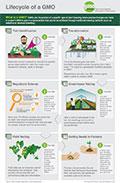ARTICLE: 6 Things About Current Food Marketing Trends That Scare Me
The following is crossposted from The Farmer's Daughter, listing some of the current food and marketing trends that worry her as a mom, and as a daughter of a farmer.
There are plenty of things wrong with current food marketing trends. From non-GMO to gluten-free, it leaves consumers confused and producers frustrated. But there a few things about it that I find worrisome, awful, and just plain scary.
1 Discourages innovation and technology to combat important problems.
Did you know that Florida’s citrus farms are in trouble because of a disease called citrus greening? Genetically modified crops might be able to help, but the popular non-GMO label could dissuade farmers from adopting them. Farmers in other parts of the world have seen solutions for devastating problems emerge in the form of GMOs, but anti-GMO sentiment has stopped them from being adopted. Tell that to the children that have gone blind due to Vitamin A deficiencies, despite the fact that golden ricecould have saved their sight. There are so many problems that we face now, and will face in the future, for which biotechnology could provide answers… if we don’t let marketing campaigns convince us otherwise.
2. Vilifies Good Food
Just because food doesn’t come with a fancy label on it doesn’t mean it isn’t any good for you. For example, conventional food is just as nutritious as organic food. But without the organic label, people perceive that there must be something wrong with the conventional foods. In reality, organic farmers use pesticides and organic food is susceptible to food borne pathogens. The same is true about the non-GMO label. People perceive that food without the label must be somehow bad for them, even though scientists have concluded that GMOs are just as safe as their non-GMO counterparts. But the marketing is designed to make those conventional products seem scary. The end result is that quality, nutritious food gets looked down upon for absolutely no reason.
3. Negatively impacts low-income consumers.
While we’re all influenced by marketing trends, food marketing trends based on fear tend to impact low-income consumers the most. Organic foods usually come at a premium price. As it turns out, when low-income consumers cannot purchase those high-priced items, they tend to just not purchase any at all. Instead, they opt for more processed foods with higher sodium and calories. Sadly, fear-based marketing turns these shoppers away from eating more fruits and vegetables just because they aren’t organic.
4. Promotes unhealthy eating disorders.
Orthorexia is an eating condition where a person fixates on eating “healthy.” Unfortunately, it can become an obsession. When people are constantly told that they must eat foods that are organic, non-GMO, natural, and all the rest…it can go over the top. The “clean” eating trends thrive on idyllic food that is completely separated from what an actual, healthy diet looks like. Just like other eating disorders, those afflicted with orthoexia can do serious damage to their health.
5. Promotes agricultural production that is less environmentally-friendly.
Non-GMO labels are particularly popular right now, but attacking biotech actually ignores important environmentally-friendly advantages. GMOs have decreased the use of pesticides, increased yields, and made practices like no-till more available. On the other hand, organic yields are generally considerably less than conventional yields, meaning the same amount of land produces less. Consumers are being tricked into thinking certain labels equate to better environmental practices.
6. It makes family farmers the bad guys.
Generally, farmers care about the environment, food quality and safety, and raising healthy animals. But you wouldn’t know that from some of the marketing claims. We’re depicted as large corporations just looking for extra profit. Consumers are warned about foods doused in pesticides and scary GMO Frankenfoods. Let’s not forget all those abused farm animals. These messages drive an even wider gap between farmers and consumers, making the former look like the bad guys. Trust me, we aren’t.
Please visit The Farmer's Daughter to read this, and all her blog posts.
